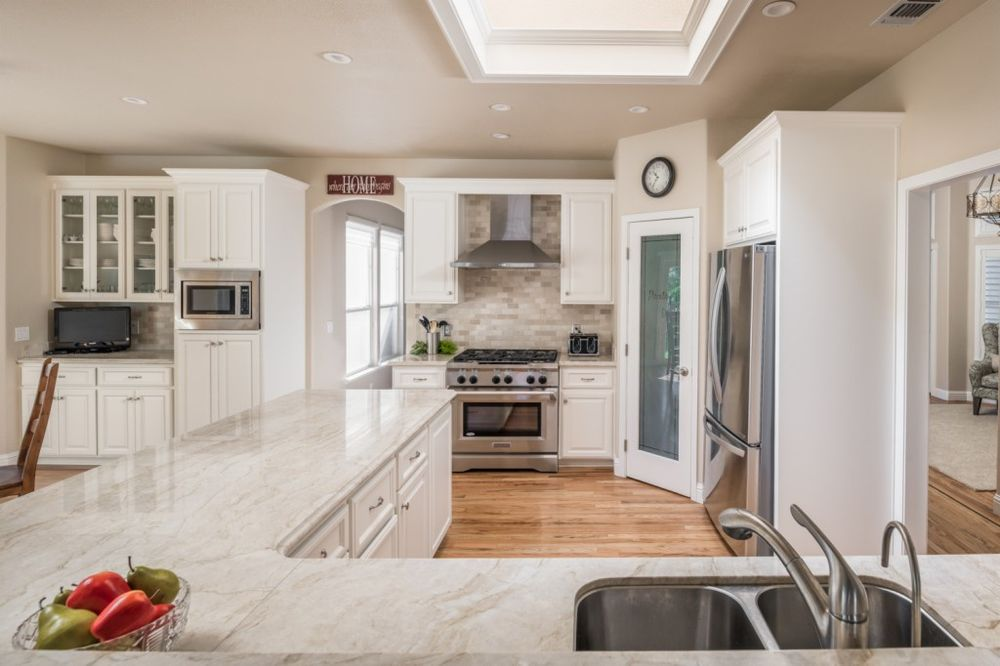-
If you’re seeking a new look for your kitchen, but are concerned about the time and cost involved with a full remodel, cabinet refacing may be a good choice for you. It promises a quicker turnaround time than a full cabinet replacement since you are keeping the structure intact and only refreshing the outer appearance and putting in new doors. As a result, the costs are also lower while the change can be quite dramatic. Read on to learn more about how it’s done.
The Process
Cabinet refacing typically involves the following steps and may take 2-4 days depending on the amount of cabinetry that needs work :
- New cabinet door material and finish are selected.
- Old cabinet and drawer fronts are removed, exposing the cabinet and drawer boxes.
- A natural wood veneer, RTF (Rigid Thermofoil), or paint is applied to the front edges inside the cabinet and other exposed areas such as the sides of the cabinet to match the new doors.
- Door hinges are replaced if the original hinges are not in good condition.
- New cabinet doors and drawer fronts are installed.
- For a more dramatic change, new hardware such as knobs, pulls, and handles are installed. However, if desired, old hardware may be used if in good condition.
- Optional accent pieces are installed such as crown molding, glass panels, lighting, or storage/organization accessories.
The Options
Now that you know what cabinet refacing involves, here’s the fun part! You’ll be directly involved in choosing the material, style, and color for your new cabinet doors! And there are hundreds of combinations to choose from! This can feel overwhelming for those who don’t have a clear vision of what they are looking for. But don’t worry, your cabinet pros will be there to help you every step of the way!
Some common cabinet materials include:
- Solid wood – Built to last, these cabinets are constructed from solid sheets of wood with no artificial binding agents. A common characteristic of all solid wood is weight. It’s heavier than engineered wood. Some popular choices include maple, pine, alder, cherry, and oak. The use of solid wood allows for wood staining.
- Particleboard – A type of engineered wood, wood particles and chips are held together by adhesive and compressed to mimic the look of solid wood. Particleboard cannot be painted over directly, so it is typically covered with veneer, laminate, or Thermofoil.
- Medium Density Fiberboard (MDF) – Slightly heavier than particleboard, this engineered wood is composed of wood fibers that are compressed together with adhesive. Like particleboard, it cannot be directly painted, so it is typically covered with veneer, laminate, or Thermofoil.
- Plywood – Thinner layers of wood are stuck together to form thicker panels of wood. This wood can be stronger than solid wood, because the layers are stacked with the grains in opposition to one another which resists breakage.
Here are some popular cabinet door styles to consider for your new cabinet doors:
- Shaker style – A middle ground between traditional and modern, this style is simple & sophisticated. It features recessed panel doors, light finishes, and minimal hardware.
- Slab style – Usually selected for contemporary kitchens where the focus is on clean lines, this style features solid, flat doors with no frames or panels.
- Rustic style – As its name suggests, the style of these cabinets mimic the raw and weathered look of cabinets in the countryside with decorative barn-inspired paneling.
- Applied moulding – Rounded, intricate, and dimensional moulding gives an interesting look to these cabinets. It’s a versatile style to complement both traditional and modern kitchens.
- Mitre styles – Precise cuts are used to create depth and produce highly-detailed cabinets with a layered look. 3” and 2 ¼” mitre styles are popular.
After choosing the cabinet style, we can further enhance the look you are going for with a variety of colors and finishes such as:
- Wood staining – Gives a natural look to pure wood and allows the wood pattern to show through. A variety of stains are available ranging for light stains to dark stains and warm tones to cool tones.
- Solid painting – A simple paint color is applied to completely cover the grains of the wood.
- High gloss finish – Perfect for modern cabinets, this finish involves a shiny lacquered being applied over the wood.
- Distressed finish – Gives the cabinets a weathered, shabby look that is suitable for those who want to add a vintage flair.
Our Cabinet Doctors-exclusive cabinet painting process results in a virtually seamless finish!
Finally, if desired, the new look is finished off with the addition of new hardware to complement the style of the cabinets.
In Conclusion
Cabinet refacing may be the answer to updating the look of your kitchen at a fraction of the time and cost. The “after” can be minimal to dramatic depending on your preferences, and will have a major impact on refreshing your space. Get a free estimate or contact us to see how we can help you get started on your cabinet refacing project!
Showroom Hours:
M-F 10am-4pm
After hours and weekends by appointment only
Creating Beautiful Kitchens
and Baths for Over 30 Years.For a complete kitchen or bath remodel, new cabinets, refacing in wood or paint,
we have the products and expertise to serve you.
Showroom Hours:
M-F 10am-4pm
After hours and weekends by appointment only(916) 632-8299
2200 Sierra Meadows Drive, Ste. A, Rocklin, CA 95677
info@thecabinetdoctors.com
License # 779523- Roseville
- Rocklin
- Fair Oaks
- Sacramento
- Lake Tahoe
- Lincoln
- Folsom
This site is protected by reCAPTCHA and the Google Privacy Policy and Terms of Service apply.
© Cabinet Doctors . All Rights Reserved. Design By Elevate Public Relations.

